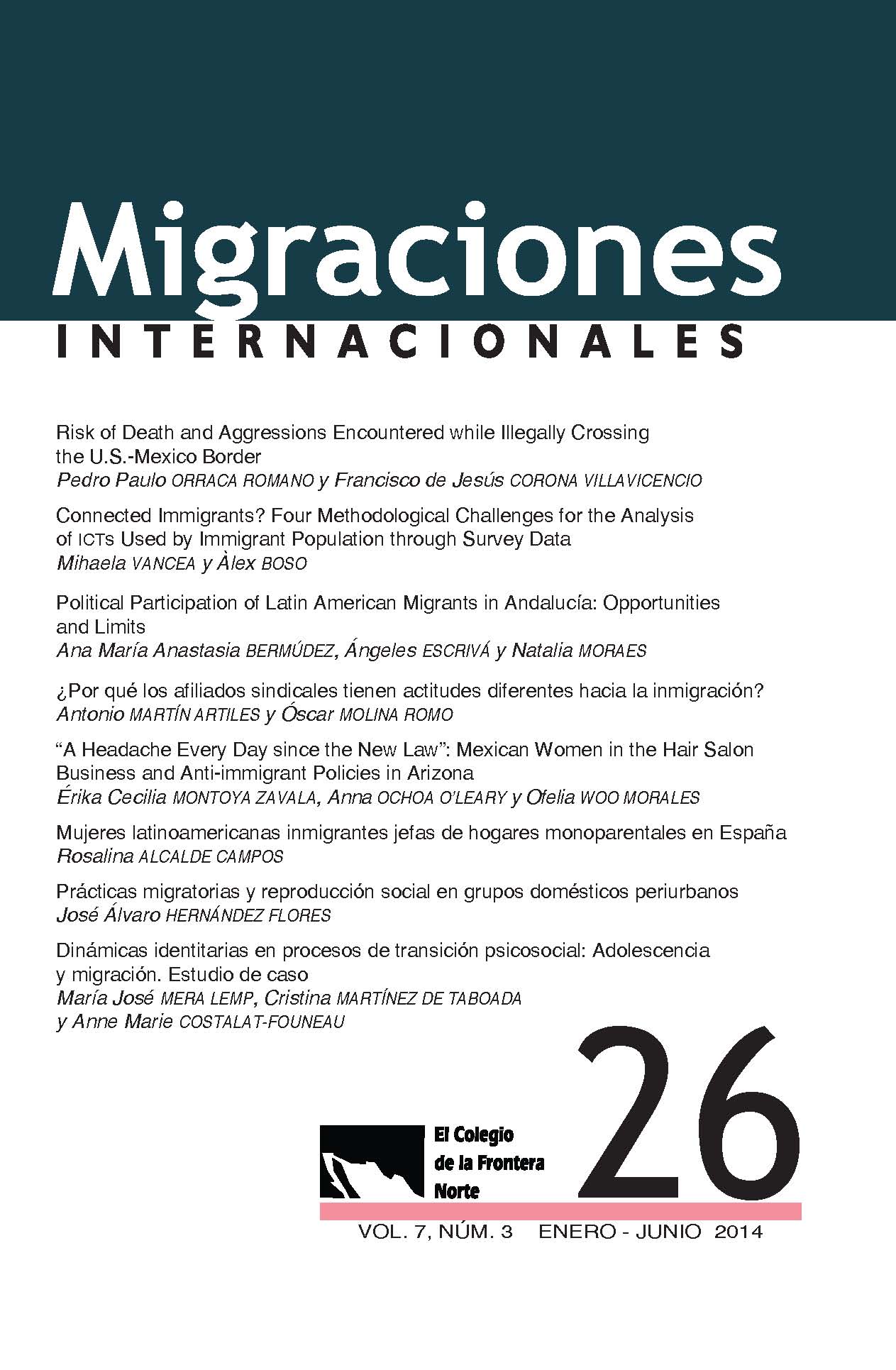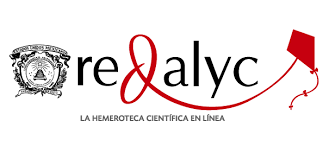Risk of Death and Aggressions Encountered while Illegally Crossing the U.S.-Mexico Border
DOI:
https://doi.org/10.17428/rmi.v7i26.669Palabras clave:
illegal migration, migrant deaths, aggression, Mexico, United StatesResumen
This article analyzes the type of migrant who is most likely to be exposed to the
risk of death or be a victim of aggression by U.S. authorities while illegally crossing
the U.S.-Mexico border, and the impact this has on the future migration inten-
tions of repatriated or deported individuals. On the basis of a logistic regression
analysis, the study shows that those most vulnerable to risk or aggressions are
first-time migrants who hire the services of human smugglers. Furthermore, mi-
grants who were previously exposed to the risk of death or whose belongings were
confiscated and never returned are less likely to engage in subsequent migration
attempts. Finally, being a victim of physical or verbal abuse at the hands of U.S.
Border Patrol agents is unrelated to future migration intentions.
Descargas
Referencias
ALDEN, Edward, 2012, “Immigration and Border Control”, The
Cato Journal, vol. 32, no. 1, Winter, pp. 107-124.
ALONSO, Guillermo, 2005, “Violencias asociadas al cruce in-
documentado de la frontera México-Estados Unidos”, Nueva
Antropología, vol. xx, no. 65, May-August, pp. 113-129.
ALONSO, Guillermo, 2012, “Recesión económica, reflujos mi-
gratorios y violencia antiinmigrante entre México y Estados
Unidos”, Norteamérica, vol. 7, no. 2, July-December, pp. 221-
ARIZONA STATE LEGISLATURE (ASL), 2007, Legal Arizo-
na Workers Act (Arizona Revised Statutes 23-211 to 23-214).
Available at <http://www.azleg.gov/ArizonaRevisedStatutes.
asp?Title=23> (last accessed on February 20, 2014).
CORNELIUS, Wayne, 2001, “Death at the Border: Efficacy and
Unintended Consequences of US Immigration Control Poli-
cy”, Population and Development Review, vol. 27, no. 4, Decem-
ber, pp. 661-685.
CORNELIUS, Wayne and Idean SALEHYAN, 2007, “Does
Border Enforcement Deter Unauthorized Immigration? The
Case of Mexican Migration to the United States of America”,
Regulation & Governance, vol. 1, no. 2, June, pp. 139-153.
CORNELIUS, Wayne et al., 2008, Controlling Unauthorized
Immigration from Mexico: The Failure of “Prevention through
Migraciones internacionales 26.indd 36 24/02/2014 06:55:26 p. m.
orraca-corona/Risk of Death and Aggressions 37
Deterrence” and the Need for Comprehensive Reform, San Diego,
University of California at San Diego.
CORTÉS, Mario, 2003, “Política inmigratoria de México y Esta-
dos Unidos y algunas de sus consecuencias”, Región y Sociedad,
vol. 15, no. 27, May-August, pp. 3-33.
DANIELSON, Michael, 2013, “Documented failures: The Con-
sequences of Immigration Policy on the U.S.-Mexico Border”,
Nogales, Jesuit Refugee Service, usa/Jesuit Conference of the
United States/Kino Border Initiative.
DELUCA, Lawrence; Marylyn MCEWEN, and Samuel KEIM,
, “U.S.-Mexico Border Crossing: Experiences and Risk
Perceptions of Undocumented Male Immigrants”, Journal of
Immigrant and Minority Health, vol. 12, no. 1, February, pp.
-123.
Emif Norte, 2005, “Encuesta sobre migración en la frontera
norte de México 2005. Base de datos”, México, El Colef/stps/
Segob/Conapo/inm/upm/sre. Available at <http://www.colef.
net/emif/bases.php> (last accessed on May 13, 2013).
Emif Norte, 2006, “Encuesta sobre migración en la frontera
norte de México 2006. Base de datos”, México, El Colef/stps/
Segob/Conapo/inm/upm/sre. Available at <http://www.colef.
net/emif/bases.php> (last accessed on May 13, 2013).
Emif Norte, 2007, “Encuesta sobre migración en la frontera
norte de México 2007. Base de datos”, México, El Colef/stps/
Segob/Conapo/inm/upm/sre. Available at <http://www.colef.
net/emif/bases.php> (last accessed on May 13, 2013).
Emif Norte, 2008, “Encuesta sobre migración en la frontera
norte de México 2008. Base de datos”, México, El Colef/stps/
Segob/Conapo/inm/upm/sre. Available at <http://www.colef.
net/emif/bases.php> (last accessed on May 13, 2013).
Emif Norte, 2009, “Encuesta sobre migración en la frontera
norte de México 2009. Base de datos”, México, El Colef/stps/
Segob/Conapo/inm/upm/sre. Available at <http://www.colef.
net/emif/bases.php> (last accessed on May 13, 2013).
Emif Norte, 2010, “Encuesta sobre migración en la frontera
norte de México 2010. Base de datos”, México, El Colef/stps/
Segob/Conapo/inm/upm/ser. Available at <http://www.colef.
net/emif/bases.php> (last accessed on May 13, 2013).
Emif Norte, 2011, “Encuesta sobre migración en la frontera
norte de México 2011. Base de datos”, México, El Colef/stps/
Segob/Conapo/inm/upm/sre/ss. Available at
colef.net/emif/bases.php> (last accessed on May 13, 2013).
Emif Norte, 2012, “Encuesta sobre migración en la frontera
norte de México 2012. Base de datos”, México, El Colef/stps/
Segob/Conapo/inm/upm/sre/ss. Available at
colef.net/emif/bases.php> (last accessed on May 13, 2013).
ESCHBACH, Karl; Jacqueline HAGAN, and Nestor RODRÍ-
GUEZ, 2003, “Deaths During Undocumented Migration:
Trends and Policy Implications in the New Era of Homeland
Security”, Defense of the Alien, vol. 26, pp. 37-52.
ESCHBACH, Karl et al., 1999, “Death at the Border”, Interna-
tional Migration Review, vol. 33, no. 2, Summer, pp. 430-454.
ESPENSHADE, Thomas, 1994, “Does the Threat of Border De-
tention Deter Undocumented US Immigration?”, Population
and Development Review, vol. 20, no. 4, December, pp. 871-892.
FELDMANN Andreas and Jorge DURAND, 2008, “Mortan-
dad en la frontera”, Migración y Desarrollo, no. 10, 1st semester,
pp. 11-35.
INFANTE, César et al., 2012, “Violence Committed against Mi-
grants in Transit: Experiences on the Northern Mexican Bor-
der”, Journal of Immigrant and Minority Health, vol. 14, no. 3,
June, pp. 449-459.
JIMENEZ, Maria, 2009, Humanitarian Crisis: Migrant Deaths
at the U.S.-Mexico Border, San Diego, United States, Ameri-
can Civil Liberties Union of San Diego and Imperial Counties
Foundation/Comisión Nacional de los Derechos Humanos.
LUHNOW, David, 2010, “Mexico Killings Show Migrants’
Plight”, The Wall Street Journal, New York, Americas News,
August 27. Available at <http://online.wsj.com/article/SB1000
html> (last ac-
cessed on May 13, 2013).
LYDGATE, Joanna, 2010, Assembly-line Justice: A Review of Ope-
ration Streamline, Berkeley, University of California at Berkeley
Law School.
MARRONI, María and Guillermo Alonso, 2006, “El fin del
sueño americano: Mujeres migrantes muertas en la frontera
México-Estados Unidos”, Migraciones Internacionales 10, vol.
, no. 3, January-June, pp. 5-30.
NEVINS, Joseph, 2003, “Thinking out of Bounds: A Critical
Analysis of Academic and Human Rights Writings on Migrant
Deaths in the U.S.-Mexico Border Region”, Migraciones Inter-
nacionales 5, vol. 2, no. 2, July-December, pp. 171-190.
NO MORE DEATHS (NMD), 2008, “Crossing the Line: Hu-
man Rights Abuses of Migrants in Short-Term Custody on the
Arizona/Sonora Border”, Tucson, United States, nmd.
OFFICE FOR NATIONAL STATISTICS, 2014, “Internation-
al Passenger Survey”, London. Available at <http://www.ons.
gov.uk/ons/guide-method/method-quality/specific/travel-and-
transport-methodology/international-passenger-survey/index.
html> (last accessed on February 20, 2014).
OFFICE OF INSPECTOR GENERAL (OIG), 2006, “Treat-
ment of Immigration Detainees Housed at Immigration and
Customs Enforcement Facilities”, Washington, DC, oig-U.S.
Department of Homeland Security, December (OIG-07-01).
PHILLIPS, Scott; Jacqueline HAGAN, and Nestor RODRI-
GUEZ, 2006, “Brutal Borders? Examining the Treatment of
Deportees During Arrest and Detention”, Social Forces, vol. 85,
no. 1, September, pp. 93-109.
RUBIO-GOLDSMITH, Raquel et al., 2006, The “Funnel Effect”
& Recovered Bodies of Unauthorized Migrants Processed by the
Pima County Office of the Medical Examiner, 1990-2005, Tuc-
son, United States, University of Arizona.
SANTIBÁÑEZ, Jorge [paper], 2000, “Riesgos asociados al des-
plazamiento migratorio internacional”, in “Diálogo Estados
Unidos-México sobre Migración”, Mexico, Secretaría de Rela-
ciones Exteriores.
SAPKOTA, Sanjeeb et al., 2006, “Unauthorized Border Cross-
ings and Migrant Deaths: Arizona, New Mexico, and El Paso,
Texas, 2002-2003”, American Journal of Public Health, vol. 96,
no. 7, July, pp. 1282-1287.
SLACK, Jeremy et al., 2013, In the Shadow of the Wall: Family
Separation, Immigration Enforcement and Security, Tucson,
United States, University of Arizona.
SOLÍS, Marlene and Alonso, GUILLERMO, 2009, “Una ca-
racterización de las mujeres en tránsito hacia Estados Unidos:
-2006”, Papeles de Población, vol. 15, no. 62, October-De-
cember, pp. 253-283.
SORENSEN, Todd and Carmen CARRIÓN-FLORES, 2007,
“The Effects of Border Enforcement on Migrant’s Border
Crossing Choices: Diversion or Deterrence?”, Tucson, Univer-
sity of Arizona, unpublished.
SOUTHERN BORDERS COMMUNITIES COALITION
(SOBOCO), 2013, “Border Patrol Abuse Since 2010”. Avail-
able at <http://soboco.org/border-patrol-brutality-since-2010/>
(last accessed on May 31, 2013).
SPENER, David, 2008, “El apartheid global, el coyotaje y el dis-
curso de la migración clandestina: Distinciones entre violencia
personal, estructural y cultural”, Migración y Desarrollo, vol.
, 1st semester, pp. 127-156.
UNITED STATES CITIZENSHIP AND IMMIGRATION
SERVICES (USCIS), 1986, “Immigration Reform and Con-
trol Act of 1986 (Pub. L.99-603)”, Washington, DC, U.S.
Department of Homeland Security. Available at
uscis.gov/sites/default/files/ilink/docView/PUBLAW/HTML/
PUBLAW/0-0-0-15.html> (last accessed on January 27, 2014).
UNITED STATES CITIZENSHIP AND IMMIGRATION
SERVICES, 1996, “Illegal Immigration Reform and Im-
migrant Responsibility Act of 1996 (Pub. L. 104-208)”,
Washington, DC, U.S. Department of Homeland Security.
Available at <http://www.uscis.gov/iframe/ilink/docView/
PUBLAW/HTML/PUBLAW/0-0-0-10948.html> (last acces-
sed on January 27, 2014).
UNITED STATES CUSTOMS AND BORDER PROTEC-
TION (USCBP), 2013, “U.S. Border Patrol Fiscal Year 2012
Statistics”, U.S. Department of Homeland Security. Available
at <http://www.cbp.gov/xp/cgov/border_security/border_patrol/
usbp_statistics/usbp_fy12_stats/> (last accessed on May 31,
.
UNITED STATES GOVERNMENT ACCOUNTABILITY
OFFICE (USGAO) [report], 2006, “Illegal Immigration: Bor-
der-Crossing Deaths Have Doubled Since 1995; Border Patrol’s
Efforts to Prevent Deaths Have not Been Fully Evaluated”,
Washington, DC, usgao.
UNITED STATES GOVERNMENT ACCOUNTABILITY
OFFICE (USGAO) [report], 2010, “Alien Smuggling: dhs
Needs to Better Leverage Investigative Resources and Measure
Program Performance along the Southwest Border”, Washing-
ton, DC, usgao.
Descargas
Publicado
Número
Sección
Licencia
Las/los autoras/es que publiquen en esta revista aceptan las siguientes condiciones:
- Las/los autoras/es conservan los derechos de autor y ceden a la revista Migraciones Internacionales (RMI) el derecho de la primera publicación, mediante el registro de los textos con la licencia de Creative Commons Atribución-No comercial-Sin derivar 4.0 internacional (CC BY-NC-ND 4.0), que permite a terceros utilizar lo publicado siempre que mencionen la autoría del trabajo y a la primera publicación en esta revista.
- Autorizan que su artículo y todos los materiales incluidos en él sean reproducidos, publicados, traducidos, comunicados y transmitidos públicamente en cualquier forma o medio; así como efectuar su distribución al público en el número de ejemplares que se requieran y su comunicación pública, en cada una de sus modalidades, incluida su puesta a disposición del público a través de medios electrónicos o de cualquier otra tecnología, para fines exclusivamente científicos, culturales, de difusión y sin fines comerciales.
- Los autores/as pueden realizar otros acuerdos contractuales independientes y adicionales para la distribución no exclusiva de la versión del artículo publicado en esta revista (por ejemplo: incluirlo en un repositorio institucional, página web personal; o bien publicarlo en un libro) siempre que sea sin fines comerciales e indiquen claramente que el trabajo se publicó por primera vez en Migraciones Internacionales (RMI), [agregando la ficha bibliográfica correspondiente: Autor/es. (año). Título del artículo. Migraciones Internacionales, volumen (número), pp. doi: xxxx ].
Para ello, las/los autoras/es deben remitir el formato de carta-cesión de la propiedad de los derechos de la primera publicación debidamente llenado y firmado. Este documento debe cargarse en formato PDF en archivos complementarios dentro de la plataforma OJS.
Este obra está bajo una licencia de Creative Commons Atribución-No comercial-Sin derivar 4.0 internacional (CC BY-NC-ND 4.0)..













